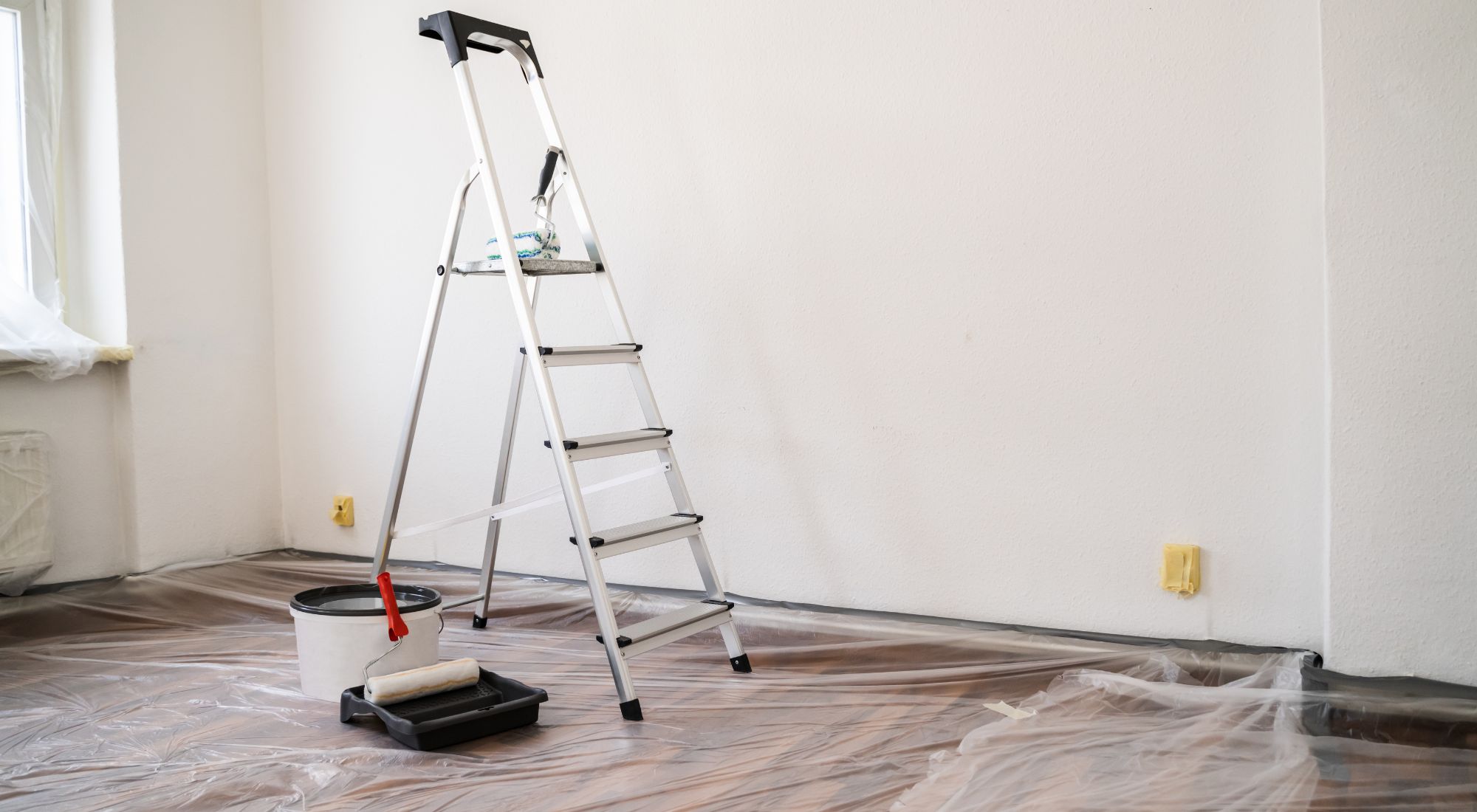You’re gearing up for a kitchen refresher with a new coat of paint and cabinet finishings. Those old cans of paint in your garage keep catching your eye. You like the color and the idea of saving a few extra dollars using what you already have.
But before you go cutting corners, you ask yourself: “Can you use exterior paint inside of your home?”
Interior and exterior paints are different and are designed for specific uses, and it’s important to choose the right one for your particular job.
In this article, we’ll compare exterior and interior paints and explain why you should reconsider using exterior paint indoors.
Table of Contents
- Exterior Paint vs. Interior Paint — What Is the Difference?
- Expanding on Exterior Paint: Typical Characteristics
- Can You Use Exterior Paint Inside?
- Why Can’t I Use Exterior Paint Inside? 4 Reasons Why Exterior Paint Is Not Suitable for Indoor Use
- What Happens If I Accidentally Used Exterior Paint Inside?
- Durable Alternatives to Using Exterior Paint Inside
- Two Brothers Painting — Professional Interior and Exterior Painting Contractors in the Portland Metro Area for Over 20 Years
Exterior Paint vs. Interior Paint — What Is the Difference?
The names of the paint types themselves clue us into the most obvious difference—one is used outside while the other is used inside. That makes enough sense, but why differentiate? Unless Big Paint is just trying to make an extra profit by having people buy more products.
As much as it would be intriguing if some seedy conglomerate ran the paint market behind the scenes (it certainly would make some of our jobs more interesting), the experts at Two Brothers Painting are here to tell you that there is indeed a tangible difference between interior and exterior paint.
To know whether you should choose interior or exterior paint for particular parts of your home, consider the following differences between the two:
- Intention: Indoor paints are intended for use indoors, where walls are often scuffed, dirtied, and washed. On the other hand, exterior paint is intended to minimize damage from the outdoor elements, where regular cleaning and scrubbing aren’t necessary.
- Formulation: Both exterior and interior paints are specially formulated to provide particular characteristics. Exterior paints are formulated with higher-quality solids that resist UV rays from the sun. Interior paints are engineered with lower solids and fewer VOCs (Volatile Organic Compounds) to withstand regular maintenance.
- Performance: Both interior and exterior paints can be expected to perform in a particular way. Interior paint used outdoors will not resist mold, mildew, or sun damage, while exterior paint used indoors leaves behind strong fumes that may be dangerous to inhale.
To make sure your paint does what you want it to do, stick to the right paint for its intended purpose or have the professionals at Two Brothers Painting help!
Expanding on Exterior Paint: Typical Characteristics
There are many parts to the exterior of a home, and when choosing the right type of exterior paint, consider that you may be using it to paint:
Certain characteristics make exterior paint the ideal paint to use for all of those areas of a home’s exterior. Weather conditions can give your home’s exterior a beating, and that’s why exterior paint is designed with higher solids to resist:
- Mold and mildew
- Fading
- Peeling; and
- Cracking
Weatherproof
Whether you live in humid Atlanta or rainy Portland, using the right exterior paint will help tackle whatever weather Mother Nature wants to dish out.
Exterior paint is designed to resist:
- Low and high temperatures
- Wet weather; and
- UV rays from the sun
This means it will provide durability throughout the year with the changing seasons and weather patterns.
Fade-Resistance
Though you’ve probably repainted walls inside your home (or had a professional tackle the job), you probably didn’t do it because your indoor paint was fading. You likely repainted indoor walls because they started looking dingy, or you just wanted a change of pace.
But with the exterior of a home, fading is one of the primary reasons for repainting. The strong UV rays of the sun are the main culprit for fading, and even the best exterior paints will fade eventually. (Most exterior paints resist fading for five to seven years.)
For this reason, exterior paints use non-organic pigments that help the color last longer and resist fading. True, these non-organic chemicals are harsh and have intense odors. But since they are used outdoors where airflow is plentiful, the fumes dissipate quickly and easily without any need to worry about inhaling harmful fumes.
Mold and Mildew-Proof
Rain and moisture. There’s simply no way to avoid it (especially if you live in the Pacific Northwest). Eventually, your home is going to be exposed to torrential weather like thunderstorms and rainstorms. And moisture is the perfect environment for mold and mildew to breed under the vulnerable siding.
That’s why exterior paints are more water-resistant than interior paints. Quality exterior paints also contain mildewcides that help keep mildew, mold, and algae at bay. Like some of the pigment chemicals that make exterior paint fade-resistant, mildewcides are not healthy to breathe in, which is another reason why exterior paints are designed to be used outside where there is sufficient airflow.
If you’d rather have a professional tackle your exterior painting job, Two Brothers Painting has the experience and know-how to get your job done in the right way with the right paint.
Can You Use Exterior Paint Inside?
While you can use exterior paints inside, it’s generally not recommended and should be avoided.
Maybe you’ve got that extra can of exterior paint in the garage, and you want to save money by using it on the walls of one of your interior rooms. Or, perhaps you think that because exterior paint is more durable, it would be the perfect paint for your walls that are easily marked or scuffed.
Exterior paints are not designed to be used indoors, and there are several reasons why it’s a good idea to keep exterior paint outside, where it belongs.
Why Can’t I Use Exterior Paint Inside? 4 Reasons Why Exterior Paint Is Not Suitable for Indoor Use
#1: Chemicals
Exterior paints, like acrylic latex paint, utilize all sorts of chemicals that have higher VOCs than interior paints. Those chemically heavy paints are formulated specifically for outdoor use.
Exterior paints may include harmful chemicals and VOCs, such as:
- Resins
- Fungicides
- Formaldehyde
- Ethyl Acetate
- And other additives
These harmful chemicals and substances may severely impact indoor air quality and leave strong paint fumes behind.
#2: Fumes
VOCs are used in exterior paints to bind the pigments in place. These chemicals cause harmful fumes that may be dangerous to your health.
Some VOCs may even cause lung cancer or lung damage.
Breathing in some of these paint fumes may also cause these milder side effects:
- Eye, nose, and throat irritation
- Difficulty breathing
- Nausea
- Lightheadedness
- Headaches
Long-term exposure to these fumes may be particularly harmful to children, the elderly, and those who struggle with asthma or other respiratory disorders.
No matter how you look at it, exterior paint used indoors may be harmful to your health. For your and your family’s safety, it’s best to keep those nasty fumes outside.
#3: Price
Just like most products, the more special ingredients that are added, the higher the price will be.
The same is true with paints. Exterior paints tend to be more expensive because they include added ingredients to increase durability, moisture resistance, and color fading resistance.
Interior paint has a simpler composition and is typically less expensive because these extra additives are not necessary.
#4: Faster Deterioration
You might not be shocked to learn that interior paint will deteriorate faster if it is used on outdoor structures. But did you know exterior paint may deteriorate faster if used indoors?
Ironically, the same additives that make exterior paint so resilient are vulnerable to scratches and fading when used indoors.
What Happens If I Accidentally Used Exterior Paint Inside?
When you use exterior paints indoors, you may potentially put your family and pets at risk of side effects caused by harsh chemicals used in outdoor paints. Exterior paint fumes linger much longer than interior paints, some taking up to six months to off-gas.
Because of their durability and environmental resistance, exterior paints contain more VOCs than interior paints.
Exposure to paint fumes and VOCs may lead to all kinds of health issues, including allergies and other types of respiratory issues.
Studies suggest that short-term exposure to high concentrations of VOCs may irritate the eyes, nose, throat, and mouth. In some instances, exposure may also damage the lungs, liver, kidneys, and central nervous system. Long-term, unabated exposure to even low concentrations of VOCs may lead to an increased risk of asthma, reduced lung function, cardiovascular disease, and cancer.
Exterior paint should only be used in a well-ventilated area, whereas interior paints can be safely used indoors without posing significant risk to the average person.
Beyond the health dangers associated with using exterior paints indoors, you may also be displeased with the finish, which can be softer and more flexible than an interior finish.
If you accidentally use exterior paint inside (or if you happen to trust someone off Craigslist to paint the interior of your home, and that’s what they used), you’ll want to have a painting professional come in to remediate the situation.
At Two Brothers Painting, we’ve seen people make this mistake before. We are more than capable of coming in and removing the exterior paint used and applying a fresh coat of the right paint in the right shade.
So, if your exterior paint just so happened to find itself on the interior of your home, don’t panic. Two Brother Painting are the pros you can trust to fix the job.
Durable Alternatives to Using Exterior Paint Inside
By now, we hope we’ve convinced you to avoid exterior paint indoors.
But if you’re concerned about durability indoors — say in your kitchen and bathroom or other high-traffic areas — you should consider these four aspects of interior paint to determine paint durability:
- Sheen
- Brand/Quality
- Primer
- Coats
- Sheen: A general guideline is that the more shine a paint has, the more durable it will be. Sheen options vary from high gloss and semi-gloss to flat or matte. High gloss works well for cabinets, trims, and doors but may be too shiny for interior walls. For interior walls that may come in contact with grease or moisture (bathrooms and kitchens), a semi-gloss sheen would be ideal.
- Brand/Quality: Paint brands are numerous, and picking the right one to use can be challenging. But quality does matter, so choosing the best paint for a particular job is key to a durable finish and the desired end result. Looking at the rates and reviews of paints on Consumer Reports may be a good place to start.
- Primer: Though priming isn’t necessary for every job, it’s helpful for many. So, if you’re tempted to skip the primer stage, there are good reasons not to. Primer may make your paint job more durable and long-lasting. One coat of primer with one coat of paint can provide a longer-lasting and more durable job than two coats of paint.
- Coats: Multiple coats of interior paint also help to make paint jobs more durable. Two or more coats can help guarantee an even distribution of paint, and multiple coats can also help prevent chipping and fading.
Have you finished this article and still have no clue what to do for your interior painting project? Don’t sweat it. Call Two Brother Painting in the Greater Portland area, and we will take care of the job for you.
Tell us about your color preferences, aesthetic goals, and lifestyle factors (you might think that information isn’t important until you’re trying to get permanent marker off of your matte finish walls), and we’ll choose a paint that is ideal for your project.
Two Brothers Painting — Professional Exterior Painting Contractors in the Portland Metro Area for Over 20 Years
Do you need a room or multiple rooms in your house painted (or maybe the whole house)?
Is your exterior looking old and tired?
Are your kitchen cabinets ready for a facelift?
Whether you are ready for a change or in dire need of a paint touch-up, Two Brothers Painting can tackle the job without cutting any corners.
We pride ourselves on our ability to handle the job with ease and deliver the best painting experience to our clients in record time.
With over 145 years of experience, our residential and commercial painting services include:
- Exterior painting
- Interior painting
- Pressure washing
- Staining and finishing
- Cabinetry and woodwork
- And more
We’ve been in the Portland area for over twenty years, and our goals are to provide exceptional service at affordable rates.
Unsure of what to do for your painting project?
Join the ranks of our many satisfied customers and call Two Brothers Painting for an estimate today.





